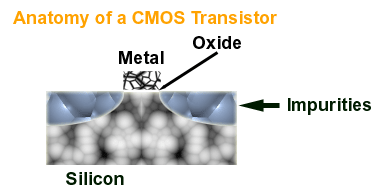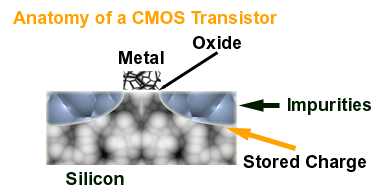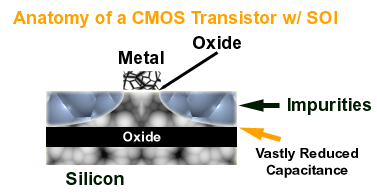Silicon on Insulator
Anyone that is even somewhat familiar with CPUs will know that they are made up of millions of transistors. In the case of the Athlon 4, there are 37.5 million transistors to be specific. But what is a transistor?
As we've explained before, a transistor is much like an electrical switch with two positions on and off. The type of transistors used in CPUs like the Athlon 4 and the Pentium 4 are what are known as Complementary Metal Oxide Semiconductors or CMOS transistors.
Today's CMOS transistors are made up of a few key parts: doped Silicon (or any other semi-conductor), metal and an oxide separating the metal from the Silicon. Silicon by itself isn't a conductor, but by introducing chemical "impurities" into the Silicon through a process known as "doping" the Silicon can conduct under certain circumstances (thus the name semi-conductor is given to it). The way a transistor conducts electricity is by applying a voltage to the metal gate that is present in the transistor. If a low voltage is present then the gate closes and current can flow through the transistor. If a high voltage is present then the gate opens and no current can flow.

Note: Thanks to AnandTech reader Todd Fuller for pointing out that modern day capacitors use a polysilicon for the gate.
This switching takes place very rapidly, and the faster our processors get the greater the need for faster and cooler running transistors becomes. One way of accomplishing this is by making smaller transistors which is what happens when processors undergo a "die shrink" (e.g. from 0.18-micron down to 0.13-micron). Unfortunately this is quite expensive and as they do get smaller their performance begins to become limited by the wiring present in the chip itself. This is where a switch from Aluminum to Copper wiring helps out, which AMD has already done with their higher clocked Thunderbirds and all Athlon 4 processors.
Another way to improve the speed of transistors is to implement a faster type of switch. Before a transistor can conduct electricity it must charge itself up and then release the charge when the transistor is switched "off." This process actually takes up quite a bit of time. Those that are familiar with this charging and release of charge will know that we are referring to the charging and discharging of a capacitor, or in this case the internal capacitance of the transistor.

If the time constant for charging and discharging the transistor can be decreased, the overall performance of the transistor can increase. This is where Silicon on Insulator (SOI) comes into play.

Silicon on Insulator reduces the internal capacitance of the transistor by sandwiching an oxide between the processor's Silicon substrate and an extremely thin layer of Silicon. This vastly reduces the amount of charge being stored between the doped Silicon and the processor's Silicon substrate which in turn allows the transistors to switch faster thus allowing higher clock speeds. SOI will also decrease the power usage of these transistors since less current is wasted charging up the capacitance of the transistors.
This technology will be first introduced by AMD with their Barton core although IBM has already demonstrated such technology in their processors.










0 Comments
View All Comments